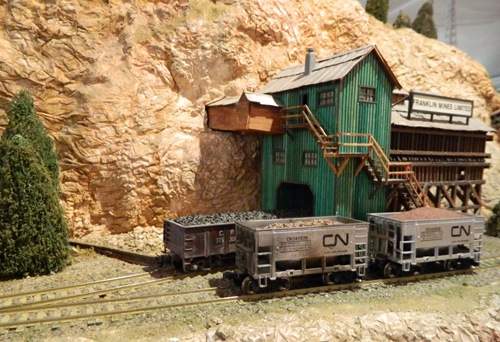
Richard Green is a behind-the-scenes kind of guy. As a Physical Resources employee, he cleans floors and disinfects washrooms in the student residences; in his free time, he’s an active member of the Guelph Model Railroad Society, where he builds the bases and the tracks the trains run on. Crucial jobs in both cases, but the kind that often go unnoticed.
Not always, though, Green says. “Sometimes students will say to me, ‘Wow, you did a great job.’”
And his fellow club members definitely appreciate his careful work on the tracks for the model trains. With about 1,500 feet of track that can run six trains at a time, the layout features the fictional Pacific Western Rail Road and has miniature towns, industries and various sidings where the trains can pass each other and move across the display.
Green says these newer trains are computer controlled, but they still sometimes get head-on collisions. “Most are caused by human error but sometimes you get runaway trains, and that’s a system problem,” he explains. “You do have to pay attention when there are several trains on the track.”
Green was one of the founding members of the club when it started in 1968. He’d always loved trains. “They still had steam engines when I was little,” he recalls. The interest in model trains came through his family: “My grandfather built three model train layouts, and he gave me one set.”
The club has tripled in size since its early days, and while the majority of members are male, they do have some women participating. The youngest member is a 14-year-old girl. Visitors are welcome (check out http://www.trainweb.org/gmrs/ for location, dates and times).
Green’s task of building up the base for the tracks is more complicated than it seems at first glance. Green explains that you begin by building a table-like base with crosspieces, adding bolts to the bottom of the table legs, giving them the ability to be levelled since floors are often uneven. Risers are used to create hills and valleys, and these are then covered with a roadbed made with strips of wood that have tiny wood blocks as spacers.
“Once you have that all glued down, you can sand the whole thing smooth,” says Green. This is then topped with another material such as cork, plywood or homasote so that the tracks can be laid down. “Once the track work is done, it’s all scenery and wiring.” While some people use Styrofoam, Green’s not a fan. In his opinion, the older techniques work better.
Green has his own set-up at home as well as his work on the Society’s tracks, so he’s familiar with the process of creating the scenery for the trains to run through: “First you have to decide what kind of job your train has to do. In the club’s layout, we have a lumber mill, an oil refinery, coal mines and other industries, so the trains move between those picking things up and dropping things off.” Then you add buildings and landscaping to make the scenes more realistic.
Green hasn’t been working at U of G for quite as long as he’s been working with model trains – he started here in 1985 – but he’s worked all over campus. Previously, he’d worked at the now-gone Knight Lumber. For his first 10 years, he worked nights cleaning in the UC, Alumni House, Alexander Hall and other buildings. Partway through that time he moved to OVC. “Animals are easier to clean up after than people,” he comments.
The night shift, while hard work, was often a lot of fun. He remembers when one of his co-workers called him to help with a problem in another part of the building; when Green arrived at the site, it was actually a surprise birthday party for him. Today, he and his colleagues still enjoy getting together for holiday parties.
In 1995, he switched to a daytime shift, looking after several student residences. Because he also fills in for other employees when needed, he’s worked in almost all the residence buildings. After more than 25 years with the University, he’s less than two years away from retirement now.
Of course, he won’t be retiring from the model railroad society; in fact, Green looks forward to having more time to create miniature worlds with trains. “I like doing track work,” he says. “I like to make sure the trains are running properly, that the alignments are right. These days I spend more time fixing things, taking care of little problems, rather than building new. There’s always something to do.”